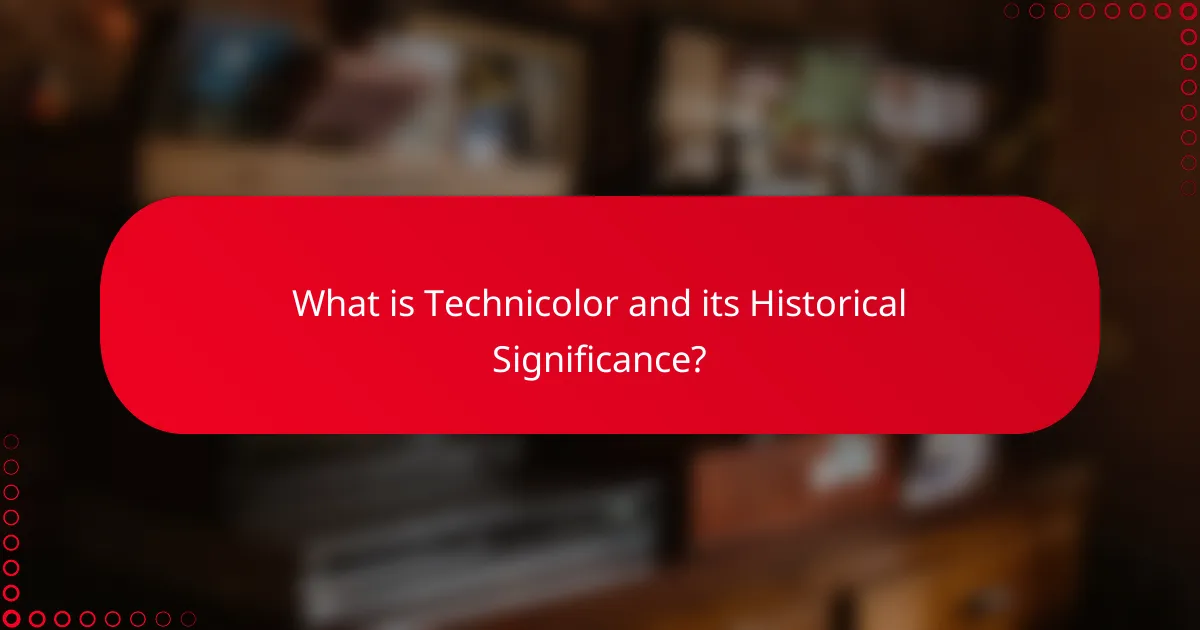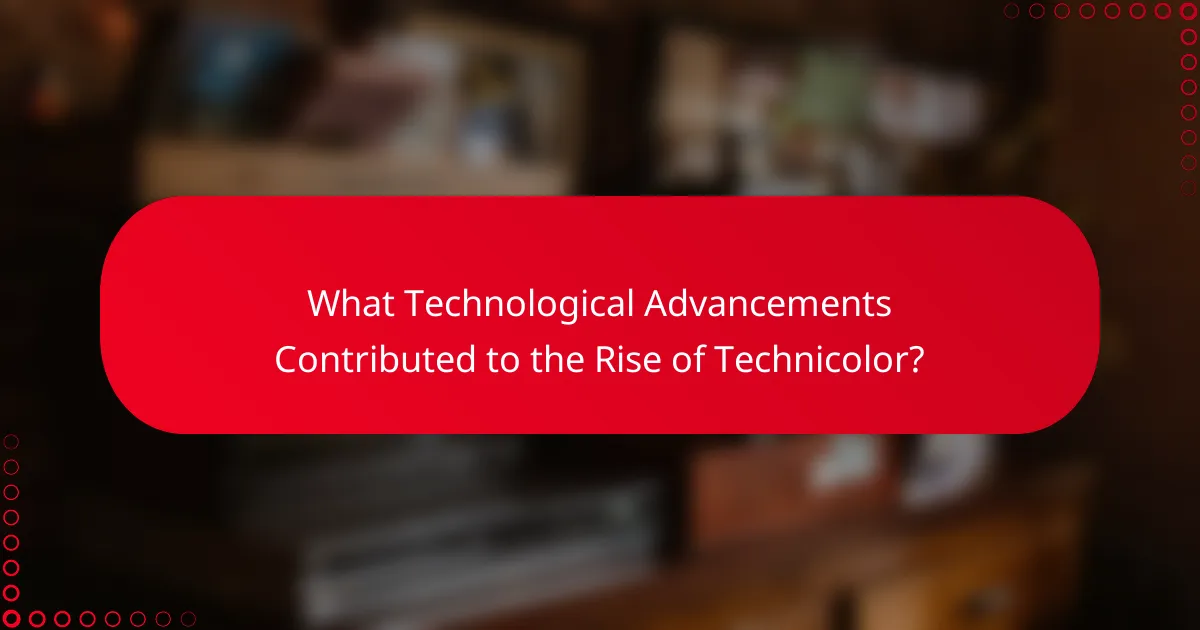Technicolor is a groundbreaking color motion picture process that transformed the film industry, first developed in the early 20th century and gaining prominence in the 1930s and 1940s. This innovative technology enabled filmmakers to create vibrant and rich colors, significantly enhancing the visual appeal of films and influencing storytelling techniques. Iconic films such as “The Wizard of Oz” and “Gone with the Wind” exemplified the capabilities of Technicolor, contributing to the golden age of Hollywood. The article explores the historical significance of Technicolor, key films that showcased its impact, and the technological advancements that facilitated its rise in cinema.

What is Technicolor and its Historical Significance?
Technicolor is a color motion picture process that revolutionized the film industry. It was first developed in the early 20th century. The process became widely recognized in the 1930s and 1940s. Technicolor allowed filmmakers to produce vibrant, rich colors on screen. This innovation significantly enhanced the visual appeal of films. Iconic films like “The Wizard of Oz” and “Gone with the Wind” showcased its capabilities. Technicolor’s impact extended beyond aesthetics; it also influenced storytelling techniques. The process helped define the golden age of Hollywood. Its historical significance lies in transforming cinematic experiences for audiences worldwide.
How did Technicolor evolve over time?
Technicolor evolved from a two-color process in the early 1900s to a three-color system by the 1930s. The first successful two-color process was introduced in 1916, featuring red and green. This method was used in films like “The Toll of the Sea.” In 1932, Technicolor developed a three-color process, allowing for a broader spectrum of colors. This innovation was first used in “Flowers and Trees,” which won an Academy Award for Best Animated Short Film. By the late 1930s, Technicolor became the standard for major Hollywood productions. Iconic films like “The Wizard of Oz” and “Gone with the Wind” showcased this vibrant color technology. The process continued to advance, leading to improvements in color accuracy and film stock. Technicolor’s evolution significantly impacted the visual storytelling of cinema.
What were the key milestones in the development of Technicolor?
Technicolor’s key milestones include its founding in 1915 by Herbert Kalmus, Daniel F. Comstock, and W. Burton Wescott. The company developed the first successful two-color process in 1917, which was used in films like “The Toll of the Sea.” In 1932, Technicolor introduced the three-color process, revolutionizing color film with “Flowers and Trees,” which won an Academy Award. The 1940s saw Technicolor become the standard for major Hollywood productions, with films like “The Wizard of Oz” showcasing its capabilities. By the 1950s, Technicolor expanded its technology to include dye transfer printing, enhancing color quality. In 1970, Technicolor transitioned into video services, adapting to industry changes. These milestones illustrate Technicolor’s evolution and impact on the film industry.
How did Technicolor impact the film industry in its early years?
Technicolor revolutionized the film industry by introducing color to motion pictures. This innovation enhanced visual storytelling and audience engagement. The first major success was “Becky Sharp” in 1935, showcasing the three-color process. This technique allowed for vibrant and realistic color reproduction. It marked a shift from black-and-white films, attracting larger audiences. By the late 1930s, Technicolor became the standard for major productions. Iconic films like “The Wizard of Oz” and “Gone with the Wind” further solidified its importance. These films demonstrated the artistic potential of color, influencing filmmakers for decades. Technicolor’s impact was foundational in establishing color as a crucial element in cinema.
Why is Technicolor important in cinematic history?
Technicolor is important in cinematic history because it revolutionized the way films were produced and perceived. The introduction of Technicolor in the early 20th century allowed filmmakers to create vibrant, visually stunning images. This technology enhanced storytelling by adding emotional depth through color. One of the first major films to use Technicolor was “The Toll of the Sea” in 1922. It showcased the potential of color in storytelling. The technique gained widespread acclaim with films like “The Wizard of Oz” and “Gone with the Wind.” These films demonstrated how color could evoke mood and atmosphere. Technicolor set a new standard for visual aesthetics in cinema, influencing future filmmaking. Its legacy is evident in the continued use of color in modern films.
What cultural shifts did Technicolor contribute to in film?
Technicolor contributed to significant cultural shifts in film, particularly in visual storytelling and audience engagement. Its introduction in the early 20th century transformed the aesthetic of cinema. The vibrant colors enhanced emotional expression and narrative depth. Films like “The Wizard of Oz” and “Gone with the Wind” showcased Technicolor’s impact, attracting larger audiences. This shift encouraged filmmakers to explore more imaginative and artistic approaches. Technicolor also influenced fashion and design trends, as audiences sought to emulate the vibrant styles seen on screen. Overall, Technicolor redefined the cinematic experience, making it more immersive and visually captivating.
How did Technicolor influence audience perceptions of films?
Technicolor significantly influenced audience perceptions of films by enhancing visual storytelling. Its vibrant colors created a more immersive experience for viewers. This technology made films visually appealing and emotionally engaging. Audiences began to associate color with quality and innovation in cinema. The first major Technicolor feature, “Becky Sharp” (1935), showcased its potential. Subsequent films like “The Wizard of Oz” (1939) further solidified this perception. The contrast between black-and-white and Technicolor films heightened audience excitement. Technicolor’s success ultimately set a new standard for film production.

What are the Key Films that Showcased Technicolor?
The key films that showcased Technicolor include “The Wizard of Oz” and “Gone with the Wind.” “The Wizard of Oz,” released in 1939, is renowned for its vibrant colors, especially during the transition from Kansas to Oz. “Gone with the Wind,” also released in 1939, utilized Technicolor to enhance its dramatic visuals and storytelling. Other notable films include “Singin’ in the Rain” and “Fantasia,” both of which effectively used Technicolor to create memorable visual experiences. These films played a crucial role in popularizing Technicolor in cinema.
Which films are considered milestones in Technicolor cinema?
Milestones in Technicolor cinema include “The Wizard of Oz,” “Gone with the Wind,” and “Singin’ in the Rain.” “The Wizard of Oz,” released in 1939, showcased vibrant colors and innovative techniques. It became iconic for its use of Technicolor to enhance storytelling. “Gone with the Wind,” also from 1939, utilized Technicolor to create a lush visual experience. This film set a standard for epic storytelling in color. “Singin’ in the Rain,” released in 1952, highlighted the artistic possibilities of Technicolor in musical films. These films collectively represent significant advancements in Technicolor technology and its impact on cinematic storytelling.
What themes and narratives were enhanced by Technicolor in these films?
Technicolor enhanced themes of fantasy, romance, and realism in films. The vibrant colors created a visual spectacle that captivated audiences. For instance, musicals like “The Wizard of Oz” emphasized escapism through colorful landscapes. Romantic films showcased emotions more vividly with rich color palettes. Historical dramas benefited from Technicolor’s ability to depict authenticity in settings and costumes. The use of color also helped to convey mood and tone effectively. In essence, Technicolor transformed storytelling by adding depth and emotional resonance.
How did the use of Technicolor differ across genres?
The use of Technicolor varied significantly across film genres. In musicals, vibrant colors enhanced the visual spectacle and energy of performances. Films like “The Wizard of Oz” showcased Technicolor to emphasize fantasy elements. In dramas, color was used more subtly to evoke emotion and mood. For instance, “Gone with the Wind” utilized Technicolor to create a rich historical atmosphere. Horror films employed darker palettes to heighten tension and fear. “The Shining” exemplifies this with its striking color contrasts. Animated films, such as Disney classics, used Technicolor for bright, engaging visuals appealing to children. Each genre adapted Technicolor to serve its narrative and aesthetic needs effectively.
What impact did Technicolor films have on popular culture?
Technicolor films significantly transformed popular culture by enhancing visual storytelling. The introduction of vibrant colors captivated audiences and changed cinematic experiences. Iconic films like “The Wizard of Oz” and “Gone with the Wind” showcased the emotional power of color. This innovation influenced fashion, art, and advertising, as colors became a vital part of cultural expression. The visual appeal of Technicolor films led to increased box office revenues and audience engagement. Technicolor also inspired filmmakers to explore new genres and creative techniques. Overall, Technicolor films left a lasting legacy on the aesthetics of cinema and popular culture.
How did Technicolor influence fashion and design trends in the 20th century?
Technicolor significantly influenced fashion and design trends in the 20th century by introducing vibrant color to film. This innovation changed how clothing and set designs were perceived. Designers began to experiment with bold colors and patterns, inspired by the vivid visuals of Technicolor films. Iconic films like “The Wizard of Oz” showcased bright costumes that set new standards in fashion. The use of color in cinema also affected advertising and retail, encouraging brands to adopt more colorful marketing strategies. As a result, the fashion industry saw a shift towards more expressive and colorful designs. This trend reflected broader cultural movements emphasizing individuality and creativity. The impact of Technicolor on fashion continues to be recognized in contemporary design.
What lasting legacies do Technicolor films have in modern cinema?
Technicolor films have left a profound legacy in modern cinema. Their vibrant color palettes transformed visual storytelling. This innovation influenced filmmakers to explore color as a narrative device. Iconic films like “The Wizard of Oz” showcased the emotional power of color. Technicolor set a standard for visual aesthetics in filmmaking. It paved the way for advancements in digital color grading. Modern filmmakers often reference Technicolor’s bold styles. This legacy continues to inspire contemporary cinematography.

What Technological Advancements Contributed to the Rise of Technicolor?
The rise of Technicolor was significantly contributed to by advancements in color film processes. Early experiments in the 1900s laid the groundwork for color cinema. The introduction of the two-color process allowed filmmakers to experiment with color. This was followed by the three-color process developed by Technicolor in the 1930s. This process provided a more vibrant and realistic color representation. The first major film to utilize this technology was “Becky Sharp” in 1935. Additionally, advancements in film stock sensitivity improved color reproduction. The development of better projectors also enhanced audience experience. These technological innovations collectively propelled Technicolor to prominence in the film industry.
How did the technical processes behind Technicolor work?
Technicolor used a three-color process to create vibrant color films. This method involved the use of three separate black-and-white films, each capturing one primary color: red, green, or blue. The films were shot simultaneously through color filters. After filming, the three negatives were combined during the printing process. This combination allowed for a full-color image to emerge. The process was patented in 1916 and became widely popular in the 1930s. Notable films like “The Adventures of Robin Hood” showcased its capabilities. Technicolor’s innovative approach revolutionized the film industry, making color an integral part of cinema.
What were the key innovations in film technology that supported Technicolor?
Key innovations in film technology that supported Technicolor include the three-color process, which used separate red, green, and blue film strips. This process allowed for a full spectrum of colors in film. The introduction of the Prizma Color process enhanced color reproduction by using a single strip of film with color dyes. The development of the Technicolor dye transfer process enabled vivid color prints by transferring dye from a matrix to the final print. Additionally, advancements in camera technology, such as the use of specialized cameras designed for color filming, improved the capture of vibrant colors. These innovations collectively transformed filmmaking and established Technicolor as a leading color process in the industry.
How did advancements in color processing change filmmaking?
Advancements in color processing revolutionized filmmaking by allowing for vibrant and realistic visuals. The introduction of Technicolor in the 1930s enabled filmmakers to present a broader color spectrum. This technology enhanced storytelling by emphasizing emotions and themes through color. Iconic films like “The Wizard of Oz” showcased the impact of color on audience engagement. The shift from black and white to color attracted larger audiences and increased box office revenues. Additionally, advancements in color processing improved the overall aesthetic quality of films. The ability to manipulate color grading further allowed for creative expression. Overall, color processing advancements transformed filmmaking into a more immersive experience.
What challenges did Technicolor face in its development?
Technicolor faced several challenges in its development, primarily related to technology and market acceptance. The initial process of creating color films was complex and expensive. Early Technicolor films required specialized cameras and film stock, which limited production capabilities. Additionally, the process was slow and labor-intensive, making it difficult to compete with black-and-white films.
Market acceptance was another significant hurdle. Audiences were initially skeptical of color films. The first successful Technicolor feature, “Becky Sharp” in 1935, helped to overcome this skepticism. However, the company continued to face competition from other color processes.
Technicolor also struggled with financial instability during the Great Depression. This affected production budgets and resources. Despite these challenges, Technicolor’s innovations ultimately transformed the film industry. The introduction of the three-color process in the 1930s was a pivotal advancement, solidifying its place in cinematic history.
How did filmmakers adapt to the limitations of early Technicolor technology?
Filmmakers adapted to the limitations of early Technicolor technology by employing various creative techniques. They often used careful lighting to enhance color vibrancy. Many filmmakers limited their color palette to ensure visual coherence. They also strategically designed costumes and sets to complement the Technicolor process. Some films utilized black and white sequences to contrast with color scenes effectively. Filmmakers learned to control color saturation to avoid oversaturation issues. Additionally, they often shot in controlled environments to minimize color distortion. These adaptations allowed filmmakers to maximize the effectiveness of Technicolor despite its technological constraints.
What role did competition play in the evolution of Technicolor?
Competition significantly influenced the evolution of Technicolor. Rival companies pushed Technicolor to innovate and improve its processes. For instance, the introduction of rival color processes like Cinecolor and Eastmancolor prompted Technicolor to enhance its own technology. This led to advancements in color accuracy and film durability. The need to maintain market dominance drove Technicolor to invest in research and development. As a result, Technicolor introduced new techniques, such as the three-color process, which became industry standards. Ultimately, competition fostered a cycle of continuous improvement within Technicolor, shaping its legacy in cinema.
What are the best practices for appreciating Technicolor films today?
To appreciate Technicolor films today, one should focus on understanding the historical context and technological advancements of the era. Watching films in their original format enhances the experience. Engaging with scholarly articles and documentaries about Technicolor provides deeper insights. Analyzing color usage and cinematography techniques enriches appreciation. Participating in film screenings or festivals dedicated to Technicolor films fosters community engagement. Collecting memorabilia or reading film critiques can deepen knowledge. Additionally, discussing these films with fellow enthusiasts can lead to new perspectives. These practices collectively enhance the enjoyment and understanding of Technicolor cinema.
Technicolor is a pioneering color motion picture process that transformed the film industry from the early 20th century, becoming prominent in the 1930s and 1940s. This article explores Technicolor’s historical significance, key milestones in its development, and its impact on visual storytelling in cinema, highlighting iconic films such as “The Wizard of Oz” and “Gone with the Wind.” It also examines the technological advancements that facilitated Technicolor’s rise, the cultural shifts it contributed to, and its lasting legacy in modern filmmaking and popular culture. Understanding Technicolor’s evolution provides insight into its role in shaping cinematic experiences and audience perceptions.
